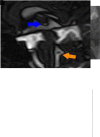Cerebrospinal fluid dynamics
- PMID: 34472743
- PMCID: PMC8491047
- DOI: 10.3325/cmj.2021.62.399
Cerebrospinal fluid dynamics
Abstract
The classical cerebrospinal fluid (CSF) circulation theory has been accepted as an established theory of CSF physiology. It describes bulk CSF flow from production site to absorption site. However, much controversy remains regarding the basic CSF physiology and the mechanisms behind the development of hydrocephalus. In the recent observations made using advanced magnetic resonance imaging (MRI) technique, namely, the time spatial inversion pulse (Time-SLIP) method, CSF was used as internal CSF tracer to trace true CSF movement. Observation of the CSF dynamics using this method reveals aspects of CSF dynamics that are different from those of classical CSF circulation theory. Cerebrospinal fluid shows pulsation but does not show bulk flow from production site to absorption site, a theory that was built upon externally injected tracer studies. Observation of the exogeneous tracer studies were true but misinterpreted. Causes of misinterpretations are the differences between results obtained using the true CSF tracer and exogenous tracers. A better understanding of the real CSF physiology can be significant for the advancement of medical sciences in the future. Revisiting CSF flow physiology is a necessary step toward this goal.
Figures







References
-
- Sachs EWH, Crawford FS. Studies on cerebrospinal circulation by new method. Arch Neurol Psychiatry. 1929:130–51.
Publication types
MeSH terms
LinkOut - more resources
Full Text Sources
Medical

